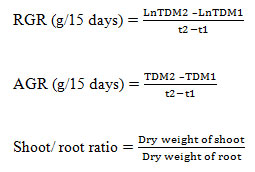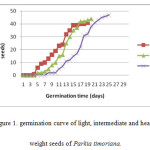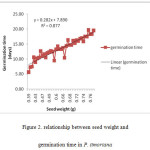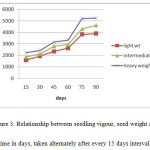Introduction
Every seed comes with a promise to give life on earth. The survival of these seeds however is greatly influence by both biotic and abiotic factors.1,2 Seed mass of species represent a complex adaptive compromises3 and plays a vital role in the establishment of the juvenile phase of a plant’s growth curve. Different species give different results4,5,6 on the effect of seed size on germination. Maximum work on this topic resulted in the more positive effect of heavier seed mass, during at least one stage of the life cycle, particularly under stress condition,3,7,8 which might be because of the larger food reserve present. Larger food reserve in seeds may permit more pre and post photosynthetic growth of seedlings and this in turn, may contribute to better growth and survival in later stages.9,10 However, negative relationship between seed mass and relative growth rate reported across species11-14 cannot be ruled out. This negative relationship helps the small or light weight seeds with less food reserve to compensate and survive unlike the initial advantage conferred to heavy seeded species.15,16 Therefore, this association may be considered as a determinant of plant demography and community composition.
Habitat or microsite variation also influence the mass, size and health of the seedling population in addition to other intrinsic characters of the seeds. The understorey of the forest, where light is limiting are occupied by competitive and tolerant seedlings produced from heavy and large seeds, while light and small seeds with faster germination inhabit the openings. An alternate temperature of 17.5˚/ 30˚C has been found to be more favourable17,18 for the seeds of Parkia roxburghii19 to get germinated. This condition closely resemble to an open forest and hence seeds of all size may germinate, while to a close canopy forest type, seeds with larger food reserve of this species might be favourable.
Parkia timoriana is one of the important leguminous tree species reported to be found only in the north-eastern states of India and some other parts of south-east Asian countries.20 The pod, flower and seed of this tree is a delicacy and consumed either raw or cooked. Hence, these plant products provide a stable flow of case income to the farmers of the region.21 Reports of its use in traditional medicine are also well known.22
Effect of seed mass on germination and early growth has rarely been analyzed. However, no related work as such has been reported for Parkia timotiana tree seeds. The objective of the present study were to see if there is any difference in seed weight derived from different provenance and if difference is there, whether seedlings derived from heavier seeds have more regeneration potential. Seed scientist and farmers could utilize this information to create a seed orchard or a plantation farm in less time and with more success.
Materials and Methods
Study Species
Parkia timoriana (D.C.) Merr, is a leguminous tree species in late successional stage. Flowers, pods and seeds of this plant are edible; therefore it is mostly grown in homestead gardens. It attains a height up to 20 m in plain and 12 m in hills, distributed across the North eastern states of India with an altitudinal range up to 1300 m asl. Under natural condition, they are mostly pollinated be bats, bees and ants, and after the seeds become mature they prefer moist shady place to germinate.
Seed Source
Mature pods were collected from twenty randomly selected trees of P timoriana at Sakawrtuchung provenance of Mizoram, India (23˚45’N, 92˚40’E, 829m asl). These pods were then let dry by keeping under direct sunlight for 10 days and then under shade for 20 days. Extraction of the seeds was done manually by using secateurs and seeds with insect and fungal attack were discarded at the same time. These extracted seeds were then bulked together and were resorted into three categories based on their seed weight as: light (<0.5g), intermediate (0.5 to 0.69 g) and heavy (≥0.7 g) respectively, for determining seed germination and seedling growth. Seeds of each class were soaked separately in distilled water at room temperature (28±2˚C) for 24 hours. Soaked seeds were sown separately in 20×17 cm polythene bags containing sieved (1mm) garden soil and watered every alternate day. Daily records were kept until seedlings ceased to emerge (30 days). A seed with a healthy white radical of about 2mm protruding through the integument was considered germinated. The seedlings were allowed to grow for three months for growth related studies.
The following germination parameters were determined:
(1) Germination percentage (GP); the number of germinated seeds as a percentage of the total number of the tested seeds is given as;
GP = (germinated seeds/total tested seeds) x 100 %
Mean germination time,23 is given as;
(MGT days) = ƩTᵢNᵢ / S
Where Tᵢ is the number of days from the beginning of the experiment, Nᵢ the number of seeds germinated per day and S is the total number of seeds germinated.
(1) Germination Index (GRI): it was calculated for each treatment using the following equation:
GRI = (G₁/1) + (G₂/2) + ………+ (Gₓ / x)
Where G is the germination day 1, 2…, and x represents the corresponding day of germination.24
(2) Germination energy (GE): it was calculated as the percentage of seed germination obtained at maximum daily germination speed.
Seedling vigour (SV): it was calculated by multiplying the seedling length and germination percentage.
Biomass Related Growth Measurement
Measurements are done every 15th day starting from the two leaved stage of the germinated seedlings. Three seedlings each were randomly selected, uprooted without damage and then taken fresh weight. Further, they are kept inside oven and dried at 80˚C for 24 hours. The dried samples were taken and weigh again in an electronic balance. These data were used to calculate the following parameters; Relative Growth Rate (RGR), average growth rate AGR) and Root/Shoot (R/S) ratio.25

Where;
TDM1 = Initial total dry weight; TDM2 = Final total dry weight
t1 = Initial time; t2 = Final time
Ln = Natural logarithm
Data Analysis
Individual seed weights were determined by weighing 255 seeds (45 damaged seeds were discarded) and then a frequency distribution was derived. From this distribution, normality was compared and tested by the K-S test. Relationship among seedling length, collar diameter and biomass for each class of seed mass namely, light, intermediate and heavy were also analysed by using ANOVA. Further calculation for linear regression followed by a regression equation was also computed for the above relationship.
Results
Seed Weight
The distribution pattern of seed weights as calculated from the frequency distribution of 255 seeds did not show lognormal distribution (K-S test: P<0.05, d = 0.163, n = 255). Seed weight (n=255) varied from 0.39g to 0.81g (mean: 0.61g ± 0.01g). Among the weight class, mid weight (0.5 to 0.69g) seeds made up 56.47% of the total population followed by heavy weight (23.14%) and then by light weight (20.39%).
Table 1: Germination Behaviour of Light, Intermediate and Heavy Seeds of Parkia timoriana.
| Seed weight class (g) | Number of seeds shown | Number of seeds germinated | Number of days for initiation of germination | Mean germination time(±SE) | Germination index | Germination energy |
| Light (<0.5) | 52 | 41 (78.85%) | 4 | 10.62±0.82 | 30.5 | 75 |
| Intermediate (0.5-0.69) | 52 | 44 (84.62%) | 5 | 12.87±0.35 | 24.35 | 80.77 |
| Heavy (≥0.7) | 52 | 47 (90.38) | 9 | 17.11±0.34 | 21.74 | 86.54 |
 |
Figure 1: germination curve of light, intermediate and heavy weight seeds of Parkia timoriana. |
Seed Germination
The total germination of P. timoriana seeds was 84.62%; 78.85% of light weight seeds, 41% of intermediate weight seeds and 42% of heavy weight seeds (table 1). Germination started on the 8th day and ended on 19th day for light weight seeds, on 5th day and 20th day for intermediate weight seeds and on the 8th and 25th day for heavy weight seeds (Figure 1). Seed weights were positively correlated with germination time (Figure 2).
 |
Figure 2: relationship between seed weight and germination time in P. timoriana. |
Seedling Growth Parameters and their Relationship
Significant positive relationship (P<0.05) between seedling length, biomass and collar diameter was found for all the three seed weights (table 2). While, comparison of the seed weights regarding the seedling parameters showed no significant difference. A gradual decrease from heavy weight to light weight was seen in all the parameters apart from the collar diameter (table 3).
Table 2: Relationship Between Seedling Length, Biomass and Collar Diameter After 90 Days of Growth for Different Weight Classes.
| Seed weight | Seedling length (sdl) | Biomass (bms) | Collar diameter (cd) | Regression equation | P value |
| LightIntermediateHeavy | 49.43±2.4354.56±2.7657.90±5.07 | 1.66±0.171.809±0.141.82±0.35 | 3.90±0.134.05±0.104.00±0.21 | sdl=4.29bms+10.33cdsdl=3.61bms+10.88cdsdl=31.62bms+2.87cd | 5.31E-076.19E-071.57E-05 |
Table 3: Corresponding Growth Parameters Observed After 90 days for the Three Weight Class; Light, Intermediate and Heavy.
| Seed weight class (g) | root length (cm) | shoot length (cm) | root dry weight (g) | shoot dry weight (g) | no of leaves | collar diameter (mm) | seedling vigor |
| Light | 19±1.53 | 30.43±0.92 | 0.27±0.03 | 1.39±0.14 | 5.33±0.33 | 3.90±0.13 | 3897.556 |
| Intermediate | 21.33±1.67 | 33.23±1.40 | 0.27±0.02 | 1.54±0.12 | 5.67±0.33 | 4.05±0.10 | 4617.149 |
| Heavy | 21.50±1.32 | 36.40±3.91 | 0.28±0.04 | 1.54±0.32 | 6.0±00 | 4.00±0.21 | 5233.002 |
Relative growth rate (RGR), average growth rate (AGR) and root shoot (S/R) ratio as determined by destructive method, revealed a general trend. RGR and AGR increases with increase in weight, while the reverse is true for R/S (table 4). Seedling vigour also has shown positive relation with increasing seed weight and the number of days (figure 3).
 |
Figure 3: Relationship between seedling vigour, seed weight and time in days, taken alternately after every 15 days interval. |
Table 4. Effect of Seed Mass on Relative Growth Rate (RGR), Average Growth Rate (AGR) and Root to Shoot (R/S) Ratio of Parkia timoriana.
| Treatments | RGR (g/15days) | AGR (g/15 days) | R/S |
| Light | 0.136 | 0.2 | 2:10.5 |
| Intermediate | 0.174 | 0.28 | 2:9.8 |
| Heavy | 0.179 | 0.33 | 2:9.5 |
Discussion
Lighter seeds with lesser food reserve can germinate and grow if the competition for light, food and space is favourable. On the other hand, large food reserve is necessary to survive under harsh condition.26 Seed mass may also be influenced by the position of seed in the pod. In Parkia timoriana, because of the difference in nutrient allocation duration during pod filling, seeds from the middle portion of the pod gave heavier weight comparing the top and the bottom region. Longer the duration of pod filling bigger and heavier will be the seeds and vice versa.27
Germination and early growth of P. timoriana seedlings were significantly affected by the weight of maternal seeds. The better germination exhibited by the heavier seeds could be the result of greater availability of food reserves in heavy seeds.25,28,29,30,31 However, light weight seeds took less time to germinate than the heavy one. This could be due to thinner seed coat, which is in agreement to the report given by several authors on other tropical tree species.30,32,33
Seed mass and seed size can be used as an important tool for predicting germination and seedling growth.34,35 Similarly, close association among leaf, pod and seed size in beans36 are also well documented. These results are in agreement to our present study which showed strong correlation among the seed weights and the seedling parameters. The assumption of common genetic influences on homogenous tissues could be the possible explanation for the above relationship. This means that homology between, leaf, stem, seed etc., may be due to the fact that at the early primordial stage every organ is initiated in a similar manner from an apical meristem.
P. timoriana seedlings from heavy seeds gave better height, leaf number and dry matter yield than seedlings from intermediate and light weight seeds. In addition to this, the positive correlation between seed weight and seedling vigour put forward the more competitive nature of heavy weight seeds.37,38
Larger food reserve in the heavy seeds could be given credit for the initial superior growth that was observed in P. timoriana. This might have accounted for the early comparative growth advantage in the seedlings. Positive correlation between seedling length, biomass and seed mass35 as reported by seed researchers highlight the above experimental result. Report of superior growth in Anacadium accidentale from larger nuts than the smaller one39 also support this relation.
Conclusion and Recommendations
Our study indicated that light and intermediate weight seeds of Parkia timoriana germinated faster than the heavy one. There was a gradual increase in seedling vigour with increasing seed mass with maximum vigour was observed in between 60 to 75 days interval. Thus the study recommends that the tree planters and other stakeholders should use heavier seeds of this species for obtaining better quality of seedling.
Acknowledgements
The first author (UT) gratefully acknowledges the grant received from the University Grants Commission, New Delhi in the form of a fellowship to carry out this research.
References
- Grubb P.J., The maintenance of species richness in plant communities: the importance of the regeneration niche. Biol Rev, 52, 107-145 (1977).
CrossRef - Harper J.L., Lovell P.H. and Moore K.G., The shapes and size of seeds. Annu Rev Ecol Syst, 1, 327-356 (1970).
CrossRef - Harper, J.L., 1977. Population Biology of Plants. Academic Press, London.
- Kapatsa M., Chimuleke M., Dominic G., and Edward M., Effect of seed size of Afzelia quanzensis on germination and seedling growth. Int J For Res, 2014, 5 (2014).
- Maru K.K. and Bo Z., Effect of priming and seed size on germination and emergence of six food-type soybean varieties. Int J Agron, 2015, 6 (2015).
- Owoh P.W., Offiong M.O., Udofia S.I. and Ekanem V.U., Effect of seed size on germination and early morphological and physiological characteristics of Gmelina arborea, Roxb. Afr Res Rev, 5(6), 422-433 (2011)
CrossRef - Silvertown J., The paradox of seed size and adaptation. Trends Ecol Evol, 4, 24-26 (1989).
CrossRef - Manga V.K. and Yadav O.P., Effect of seed size on developmental traits and ability to tolerate drought in pearl millet. J Arid Environ, 29, 169-172 (1995).
CrossRef - Harper J.L. and Obeid M., The influence of seed size and depth of showing on the establishment and growth of varieties of fibre and oil seed flax. Crop Sci, 7, 527-532 (1967).
CrossRef - Stanton M.L., Seed variation in wild redish: effect of seed size on components of seedling and adult fitness. Ecology, 65, 1105-1112 (1984).
CrossRef - Reich P.B., Tjoelker M.G., Walters M.B., Vanderklin D.W. and Buschena C., Close association of RGR, leaf and root morphology, seed mass and shade tolerance in seedling of nine boreal tree species grown in high and low light. Funct Ecol, 12, 327-338 (1998).
CrossRef - Reich P.B., Buschena C., Tjoelker M.G., Wrage K., Knops J., Tilman D. and Machado, Variation in growth rate and ecophysiology among 34 grassland and savana species under contrasting N supply: a test of functional group differences. New Phytol, 157, 617-631 (2003).
CrossRef - Wright I.J. and Westoby M., Difference in seedling growth behaviour among species: trait correlations across species, and trait shifts along nutrient compared to rainfall gradients. J Ecol, 87, 85-97 (1999).
CrossRef - Castro J., Reich P.B., Miranda A.S. and Guerrero J.D., Evidence that the negative relationship between seed mass and relative growth rate is not physiological but linked to species identity: a within family analysis of Scots pine. Tree Physiol, 28, 1077-1082 (2008).
CrossRef - Norgren O., Growth analysis of Scots pine and lodgepole pine seedlings. Forest Ecol Manag, 86, 15-26 (1996).
CrossRef - Paz H., Mazer S.J. and Martinez-Ramos M., Seed mass, seedling emergence and environmental factors in seven rain forest Psychotria (Rubiaceae). Ecology, 80, 1594-1606 (1999).
CrossRef - Fabio S., Daniela C.M.V., Edson S. and Massanori T., Influence of light and temperature on seed germination of Cereus pernambucensis Lemarie (Cactaceae). 10(2), 53-56 (2010).
- Birendra K., Ekta G., Himanshi M. and Muhanad W.A., Constant and alternating temperature effects on seed germination potential in Artemisia annua L. 27(6), 636-642 (2013).
- Sahoo U.K., Upadhyaya K. and Lalrempuia H., Effect of pretreatment and temperature on the germination behaviour of seeds of Parkia roxburghii G Don. For Trees Livelihood, 17, 345-350 (2007).
CrossRef - Hopkins H.C., The taxonomy, reproductive biology and economic potentials of Parkia in Africa and Madagascar. Bot J Linn Soc, 87, 136 (1983).
CrossRef - Rocky P. and Sahoo U.K., Tree bean (Parkia roxburghii G. Don) in Imphal West district of Manipur, J Non-Timber For Prod, 11(2), 135-139 (2002).
- Khan M.H. and Yadava P.S., Antidiabetic plants used in Thoubal district of Manipur, Northeast India. Indian J Tradit Know, 9(3), 510-514 (2010).
- Scott S.J., Jones R.A. and Williams W.A., Review for data analysis methods for seed germination. Crop Sci, 24, 1192-1633 (1984).
CrossRef - Esechie H., Interaction of salinity and temperature on the germination of sorghum, J Agron Crop Sci, 172, 194-199 (1994).
CrossRef - Offiong M.O., Variation in growth and Physiological characteristic of Xylopia aethopica (DUNAL). A Rich from Akwa Ibom and Cross River States. Ph.D Thesis. Department of Forest Resources Management. University of Ibadan, Ibadan, 255(2008).
- Howe H.F. and Richter W.M., Effect of seed size on seedling size in Virola surinamensis: a within and between tree analysis. Oecologia, 53, 347-351 (1982).
CrossRef - White J.W. and Izquierdo J., Dry beans: Physiology of yield potential and stress tolerance. Centro Internatial de Agricultura Tropical, Cali, Colombia, and FAO RegionalmOffice for Latin America and the Caribbean. Santiago, Chile, 333(1989).
- Tripathi R.S. and Khan M.L., Effects of seed weight and microsite characteristics on germination and seedling fitness in two species of Quercus in a subtropical wet hill forest. Oikos, 57, 289-296 (1990).
CrossRef - Ke G. and Werger M.J.A., Different responses to shade of evergreen and deciduous oak seedlings and the effect of acorn size. Acta Oecol, 20, 570-586 (1999).
CrossRef - Khan M.L., Bhuyan P., Uma Shankar and Todaria, N.P., Seed germination and seedling fitness in Mesua ferra L. in relation to fruit size and seed number per fruit. Acta Oecol, 20, 599-606 (1999).
CrossRef - Khan M.L. and Uma Shankar, Effect of seed weight, light regime, and substratum microsite on germination and seedling growth of Quercus semiserrata Roxb. Tropical Ecol, 42, 117-125 (2001).
- Marshall D.L., Effect of seed size on seedling success in three species of Sesbania (Fabaceae). Am J Bot, 73, 457-464 (1986).
CrossRef - Murali K.S., Pattern of seed size, germination and seed viability of tropical tree species in Southern India. Biotropica, 29, 271-279 (1997).
CrossRef - Oni O. and Bada S.O., Effects of seed size on seedlings vigour in Idigbo (Terminalia ivorensis. A. Chev). J Trop For Sci, 4(3), 218 (1992).
- Simmone R., Ter Steege H. and Werger M., Survival and growth in gaps – A case study for tree seedlings of 8 species in the Guyanese Tropical Rainforest in seed seedlings and gap size matters. Troplenbos-Guyana programmes. (2000).
- Duarte R.A. and Adams M.W., A path coefficient analysis of some yield component interrelations in field beans (Phaseolus vulgaris L.). Crop Sci, 12(5), 579-582 (1972).
CrossRef - Bonfil C., The effects of seed size, cotyledon reserves, and herbivory on seedling survival and growth in Quercus rugosa and Q. laurina (Fagaceae). Am J Bot, 85, 79-87 (1998).
CrossRef - Long T.J. and Jones R.H., Seedling growth strategies and seed size effects in fourteen oak species native to different soil moisture habitats. Trends Ecol Evol, 11, 1-8 (1996).
CrossRef - Faluvi M.A., Investigations of seedlings vigour in cashew (Anacardium occidentale). Plant Breeding, 97, 237-245 (1986).
CrossRef
